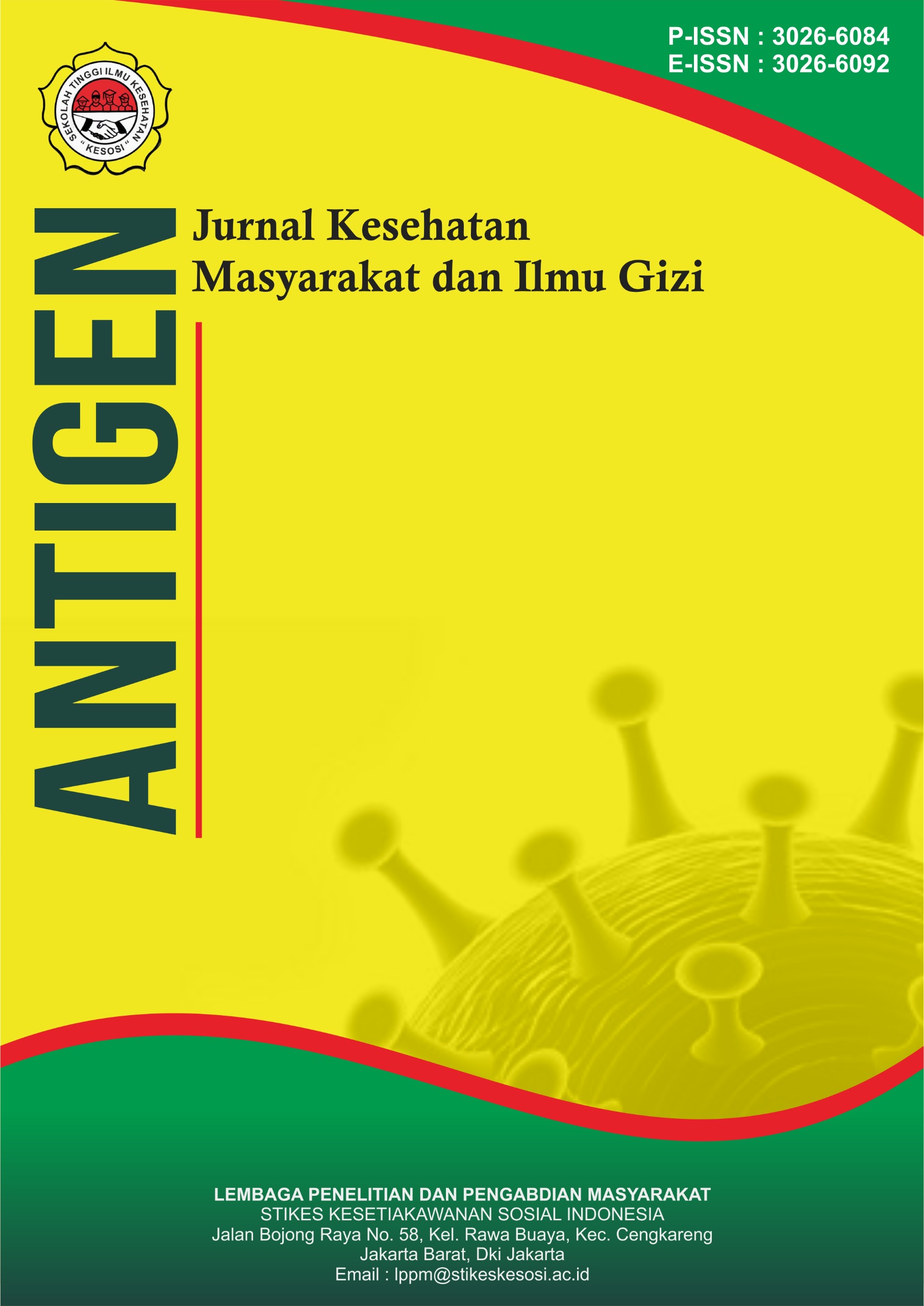Faktor Faktor yang Berhubungan dengan Stres Kerja pada Pegawai Sekertariat Jenderal Dewan Perwakilan Rakyat Republik Indonesia
DOI:
https://doi.org/10.57213/antigen.v3i3.777Keywords:
work stress, individual characteristics, workload, Social Support, DPR RI employeesAbstract
This study aims to identify factors associated with work stress among employees of the Secretariat General of the Indonesian House of Representatives, particularly individual characteristics, workload, and social support. This study uses a cross-sectional design with a quantitative approach. The study sample consisted of 370 employees of the Secretariat General of the Indonesian House of Representatives, selected using stratified random sampling. Data analysis was conducted using the Chi-Square test for bivariate analysis and logistic regression for multivariate analysis. The results of the study indicate that 53.8% of employees experience high work-related stress. Individual characteristics (age, gender, education, length of service) do not show a significant relationship with work-related stress (p > 0.05). Workload has a very significant and perfect relationship with work-related stress (X² = 370,000; p < 0.001; Cramer's V = 1.000). Social support showed a highly significant negative relationship with work-related stress: support from superiors (OR = 5.65; p < 0.001), support from colleagues (OR = 5.72; p < 0.001), and support from family (OR = 5.89; p < 0.001). Workload is the primary predictor of work-related stress, while social support acts as a protective factor. Individual characteristics do not have a significant impact in the context of the Indonesian House of Representatives, indicating the dominance of situational factors. Recommendations: The implementation of a real-time workload monitoring system, supportive supervisor development programs, and strengthening social support through team-building activities and Employee Assistance Programs are needed to reduce work-related stress among employees.
References
Departemen Kesehatan Republik Indonesia. (2009). Pedoman pencegahan penyakit akibat kerja. DepKes RI.
Hammer, L. B., Kossek, E. E., Anger, W. K., Bodner, T., & Zimmerman, K. L. (2011). Clarifying work–family intervention processes: The roles of work–family conflict and family-supportive supervisor behaviors. Journal of Applied Psychology, 96(1), 134.
Handoko, J. C., & Rahardjo, J. (2017). Perancangan Hazard Identification, Risk Assessment, And Determining Control (HIRADC) Di Schneider Electric Cikarang. Jurnal Titra, 5(2), 159–164.
House, J. S. (1983). Work stress and social support. Addison-Wesley Series on Occupational Stress.
Indonesia, K. K. R. (2018). Hasil riset kesehatan dasar (Riskesdas) 2018. Kemenkes RI.
International Labour Organization. (2016). Workplace stress: A collective challenge. ILO Publications.
Johnson, J. V, & Hall, E. M. (1988). Job strain, work place social support, and cardiovascular disease: a cross-sectional study of a random sample of the Swedish working population. American Journal of Public Health, 78(10), 1336–1342.
Lazarus, R. S. (1984). Stress, appraisal, and coping (Vol. 464). Springer.
Matud, M. P. (2004). Gender differences in stress and coping styles. Personality and Individual Differences, 37(7), 1401–1415.
Ng, T. W. H., & Feldman, D. C. (2010). The relationships of age with job attitudes: A meta‐analysis. Personnel Psychology, 63(3), 677–718.
Notoatmojo, S. (2012). Promosi kesehatan dan Perilaku kesehatan. Rineka Cipta.
Rivai, V. (2016). Manajemen sumber daya manusia untuk perusahaan.
Robbins, S. P., & Judge, T. A. (2017). Organizational Behavior 17th Global Edition. Lego, Italy: Pearson.
Spector, P. E., & Jex, S. M. (1998). Development of four self-report measures of job stressors and strain: interpersonal conflict at work scale, organizational constraints scale, quantitative workload inventory, and physical symptoms inventory. Journal of Occupational Health Psychology, 3(4), 356.
Steptoe, A., & Kivimäki, M. (2013). Stress and cardiovascular disease: an update on current knowledge. Annual Review of Public Health, 34(1), 337–354.
Theorell, T. (1992). Healthy work: Stress, productivity and the reconstruction of working life. Basic Books.
Theorell, T., Hammarström, A., Aronsson, G., Träskman Bendz, L., Grape, T., Hogstedt, C., Marteinsdottir, I., Skoog, I., & Hall, C. (2015). A systematic review including meta-analysis of work environment and depressive symptoms. BMC Public Health, 15, 1–14.
Viswesvaran, C., Sanchez, J. I., & Fisher, J. (1999). The role of social support in the process of work stress: A meta-analysis. Journal of Vocational Behavior, 54(2), 314–334.
World Health Organization. (2019). Mental disorders in the workplace: Information sheet. WHO Press.
Downloads
Published
Issue
Section
License
Copyright (c) 2025 Antigen : Jurnal Kesehatan Masyarakat dan Ilmu Gizi

This work is licensed under a Creative Commons Attribution-ShareAlike 4.0 International License.






